Dassault Mirage IIICJ

Eduard
S u m m a r y
|
|
Catalogue Number and Description: |
8102 -
Dassault Mirage IIICJ |
|
Scale: |
1/48 |
|
Price: |
£
21.79
http://www.hannants.co.uk and
USD$42.46 http://www.Squadron.com |
|
Review Type: |
First
Look and comparison with older Heller kit. |
|
Advantages: |
Totally
new mould; dimensionally accurate; very fine engraved surface
detail; Detailed cockpit, wheel-bays and turbine/afterburner; Good
initial selection of stores; Further members of the Mirage family
appear to be in the making. |
|
Disadvantages: |
Lack of
location pins may be a problem to some inexperienced modellers. |
|
Recommendation: |
Highly
Recommended |

Eduard's 1/48
scale Mirage IIICJ is available online from
Squadron
Reviewed
by Sinuhe Hahn & Piet van Schalkwyk
Introduction
Some
historians have described the Dassault Mirage as the culmination of three
Germans systems developed during WW2:
-
The delta wing, patented by Prof. Alexander Lippisch
in the 1930‘s (and who was also awarded a patent in 1942 for variable
geometry swept wings - to be evaluated in the Messerschmidt P 1011), who
contributed to Convair’s F-102 and F-106 series of interceptors, where
the delta design was modified by the inclusion of a wing camber to
assist with low speed handling.
-
The BMW 003 and 018 family of axial-flow turbojets,
whose post-war development was pursued by the BMW design team under the
guidance of Dr. Hermann Oestrich in Rickenbach, Switzerland, under the
name of Atelier Technique Aeronautique Rickenbach (ATAR). This group was
later moved to France to be incorporated in SNEMCA.
-
Twin 30mm cannons of the type pioneered by Mauser,
which were later developed into the Aden (UK) and Defa (France) gun
platforms.
While
this may appear a flippant assertion - credit has to be given to Marcel
Bloch in combining these three innovations with incredible Gallic flair to
produce one of the most successful jet fighter designs of all times. Indeed,
the use of designs of German origin are very ironic in this instance, in
that Marcel's story is in itself remarkable and a proud testament to this
visionary person. Well known for his pre-WW2 designs, Marcel was transferred
to Germany after the fall of France, where it was felt that his technical
skills could be put to good use. However, this was not to be, and after
categorically refusing to assist the Nazi war effort, by acting as director
of the Frankfurt Focke-Wulf plant, Marcel was sentenced to death and
interned in Buchenwald. Here his life was saved by the cunning of his fellow
inmates who exchanged his prison ID number with that of a deceased inmate.
Mirage Genesis
Upon his
return to post-war France, Marcel adopted the pseudonym that his brother had
used in the French resistance "Dassault" and in 1947 formed the company "Groupe
Marcel Dassault". Immediate post war activities included the successful
acquisition of a licence to build the DH Vampire powered by the reliable
and excellent centrifugal flow Rolls-Royce Nene Jet engine. The limitations
of the DH design soon, however, became evident (the “Spidercrab” was not one
of de Havilland’s more aesthetic designs) and Marcel's crew designed a much
more aerodymically pleasing aircraft which fitted the superb Rolls-Royce
engine like a glove, the MD 450 Ouragan, for which 350 orders were secured.
This design formed the basis for Mystere family of aircraft, which in 1954
became the first European aircraft to exceed the speed of sound in level
flight.
In 1953
Dassault was awarded a contract to develop a new lightweight interceptor for
the France Air Force, who requirements included an all weather weapons
system and speed in excess of Mach 1.3. Initial designs included the
delta-winged Myster -Delta MD 550, later dubbed Mirage 1, powered by 2 MD
30R Armstrong Siddely Viper jet engines with afterburners (980 kp thrust
each), which reached Mach 1.3 in 1956, and with rocket assistance, Mach 1.6.
This design was, however, soon found to be lacking in many aspects,
especially in that it was too small to incorporate the required weapons
systems, and although a slightly larger Mirage 2 was considered, the Mirage
III was born.
The most
significant contribution to this 30% larger aircraft without a doubt was the
single SNEMCA Atar 101 G-1 afterburner equipped turbojet engine with 4400
kp thrust. In addition the protoytpe Mirage III design also included a SEPR
66 rocket engine with a further 1500 kp thrust. On its first flight in 1956
the prototype reached Mach 1.52 and with rocket assistance Mach 1.8.
Encouraged by these results, a pre-series of 10 Mirage lllA were ordered,
with an almost 20% larger wing and reduced camber, with which speeds in
excess of Mach 2.2 were achieved. One of these aircraft was test fitted with
a Rolls Royce Avon 67 jet engine with 7258 kp thrust, as was tested as the
prototype for the Mirage IIIO in Australia. These aircraft formed the basis
of the Mirage IIIC (single seat interceptor) and the IIIB, a two-seat
trainer, whose test-flight program was initiated in October 1960. Aircraft
were delivered to France (95 Mirage IIIC), Israel (72 IIICJ), South Africa
(16 IIICZ) and one IIIC to Switzerland for evaluation. It was in Israelli
service, who were already familiar with other Dassault products, such as the
Ouragan and Mystère, that the Mirage really blazed a trail into aviation
history, attaining a combat record not equalled by any of its peers. These
exploits are described in the superb series of books by Amos Dor (IAF
Aircraft Series/AD Graphics) as well as in the new Opsrey Combat series.
Mirage III in South African Service
Although
the SAAF Mirage IIICZ's were never involved in any air-superiority combat
activities (this role being performed by the younger brother, the Mirage
F1CZ), the CZ was extensively used in the "Border Conflict in Angola", where
one of its most memorable feats was the destruction of a column of Angolan
T-34 tanks and BRDM armoured fighting vehicles in 1978. These endeavours are
described in "The South African Air Force at War" by Martin Louw and Stefaan
Bouwer.
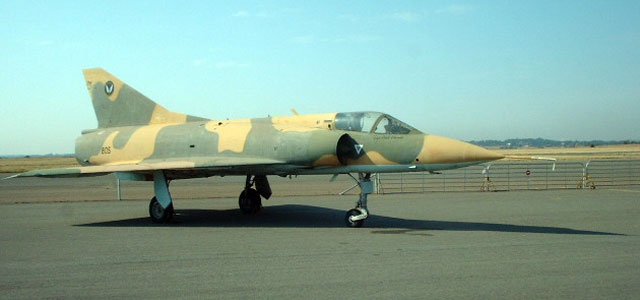
Click the thumbnails below to view
larger images:
Mirage IIIE and Related Developments
The
soundness of the basic Mirage design was quickly exploited by the Dassault
team and in 1961 work was initiated on the ground attack version, IIIE,
powered by the stronger Atar 09C-3 (6200 kp thrust) and redesigned fuselage
(30 cm extension behind the cockpit to house the additional avionics and new
tail section). This was followed by dedicated reconnaissance versions (IIIR),
lightweight ground attack versions (V), the overweight and grossly
over-budget Swiss variant equipped with the Hughes Taran-18 weapons system
and AIM-26B Falcon missiles (IIIS), as well as the Avon-powered IIIO
Australian variant.
In total
more than 1400 aircraft (and more than 60 variants) were delivered which
served with more than 20 nations. Truly a post-war success story, continued
as the Mirage 2000 family by Dassault, and as domestically modified
Cheetah's, Panters, Neshers, Daggers and Kfirs elsewhere.
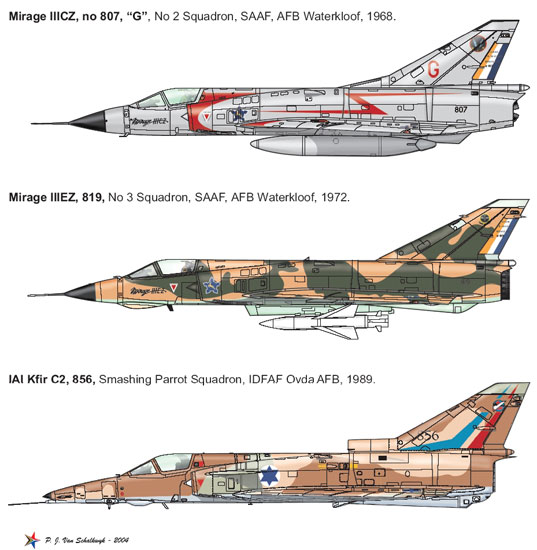
The
Mirage III in kit form
|
Despite
it's widespread use, there has never been an abundance of the Mirage III
kits in any scale. In '72 scale the IIIC/B have been released by Matchbox,
whilst the IIIE/V/R was the topic of Revell and Heller releases. These have
all been superceded by the High Planes family, which while being short-run,
are very accurate and can be built into exacting replicas. This family also
includes later developments, such as the South African Cheetah.
In 1/48
scale, early attempts (all in 1/50 scale) were made by Heller and Fujimi
(the latter are unfortunately still being marketed by Academy).
In the
early 1980's Esci attempted to redress this issue by releasing a
substantial part of the Mirage III family (IIIC, IIIE, IIIS, IIIO and V).
Although acceptable in their day, these aircraft suffered from aspects
common to all ESCI kits of that time, barely adequate cockpit detail, too
shallow wheel wells and raised panel lines. There was also some query about
the accuracy of the shape - the complex Mirage wing is tricky to capture
accurately. After the demise of ESCI, these kits have become quite scarce,
and are only now slowly being re-released by Italeri.
At about
the same time, Heller released a very pleasing IIIB/C, if slightly difficult
to construct, which permitted either the single seat interceptor or twin
seat trainer to be built. This kit, which is still available, was generally
regarded by Mirage aficionados to be the most accurate Mirage III in kit
form. It also formed the basis for a number of after-market modifications,
including a IIIO/D (by Red Roo products) and Kfir /Cheetah family by Eagle
Designs. This kit, however, suffered from the same deficits as the ESCI
series: raised panel lines, poor cockpit detail, and appallingly empty wheel
wells, none of which has ever been addressed by any after-market suppliers,
although Heller did make an attempt to release an improved "Hi-Tech" version
which included photo-etch and white metal details.
In 1/32
scale, a very decent Mirage IIIE/V/R/S was released by Revell - decent for
it's time, that is. This kit has recently been re-released to commemorate
the passing of the Swiss Mirage IIIRS from service in 2003.
Eduard's new 1/48 scale Mirage IIICJ
The news, therefore, about
a year ago that Eduard was to release a brand new cutting edge Mirage III in
1/48 scale certainly raised the spirits (and expectations) of Mirage fans
world-wide.
So what's in the box and how does it shape up?
Upon receiving my parcel from Karaya (www.karaya.pl) I was immediately
impressed by the size of the box - the biggest I have ever seen a kit from
Eduard in, or for that matter, any other Mirage III kit in '48 (the
dimensions of this box are very similar to those of the Classic Airframes SM
79).
The box contains 167 pieces
(the Heller Hi-Tech kit contains 88 parts) arranged on 8 sprues, exhibiting
some of the most elaborate injection gates that I have seen.
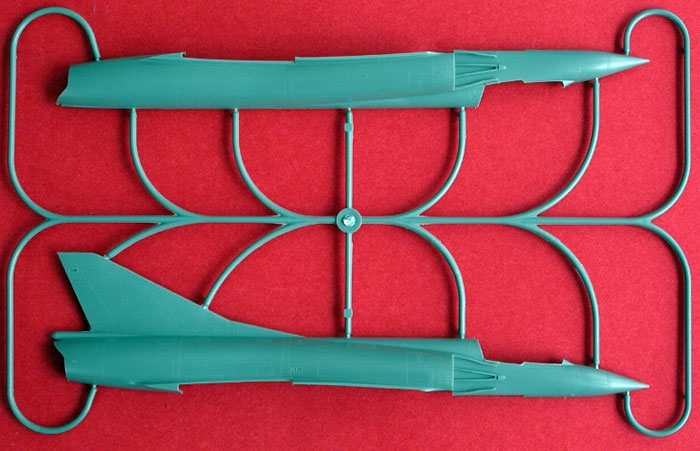
Click the thumbnails below to view
larger images:
The sprues are separately
packaged as pairs using the interlocking system Eduard has previously used
in its Ki-155 Tsurugi. The kit also contains some nice pre-painted
photo-etch details (seat belts and ejection seat handles), a cast weight to
be inserted in the nose, and painting masks for the canopy and aircraft
markings (e.g. the red trim and the intakes and white panels on the fin) - a
very nice touch.
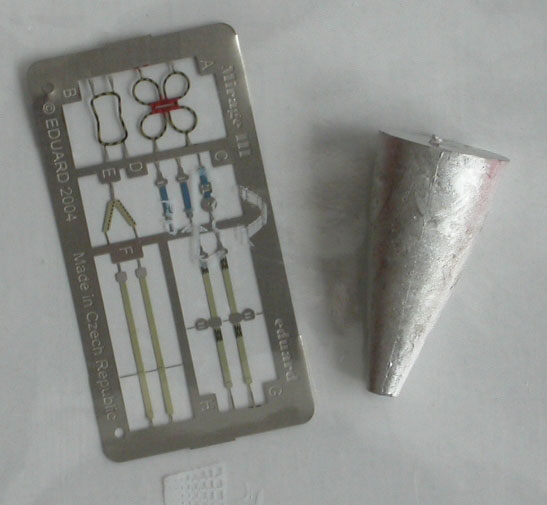
The level of detailing on
the parts is superb: very fine engraved panels (no Matchbox trenches) and
rivet detail. Truly up to the best standard that Eduard has released to date
(can anybody still remember their first generation kits e.g. the Fokker DVI
and co?). What a quantum leap in development. The kit does still exhibit one
Eduard oddity - no locating pins. Query: does the difference between
assembler or builder still seems to hold true here? My few dry-fitting
attempts do, however, indicate that the fit of the model is very good, but
that care will have to be taken with the alignment.
When comparing this kit to the Heller IIIC, it appears that Eduard have
managed to get the dimensions spot on - if anything this kit seems to
capture the sleek and elusive Mirage shape, especially the complex delta
wing plan form, more accurately than its 20 year younger Gallic
predecessor.
The level of detailing is truly superb - I know I am waxing lyrical - and
the subject is an aircraft that I love - but finally we have a
state-of-the-art kit of this historically important aircraft. This is
evident from the 6 part ejection seat, which can be “sexed” up with a number
of additional PE details.
The cockpit tub is also a
multi-piece affair, and has raised detail which can be easily picked out by
dry-brushing. A small note: Mirage cockpits tended to be close-fitting and
overall black, so not much is visible anyway. For those who like to
reminisce about the past, a blank instrument panel and side-panels and
matching decals are included - memories of ESCI!
In contrast to the Heller
kit, the wheel-bays are well detailed, each consisting of approximately 6
pieces, and unlike the ESCI kit, they are of the right depth. Loads of
detail is present for those who want to go to town on this.
The intakes of the Eduard
kit are also not blanked off like the Heller or ESCI kits, but do not lead
to the jet engine, but rather, lead into a clever clam system, which should
provide a good illusion of depth. This seems to be fair and simple solution,
as the Atar turbine is not visible through the intakes. This is also the
first kit to offer details of the turbine and afterburner with clam-shell
system. As already mentioned, a cast nose weight is included with the kit,
to prevent it being a tail sitter. The under carriage also exhibits a better
level of detail than before, which can easily be improved by the addition
of break-cables: very pronounced and readily visible on the real thing. The
kit is rounded off by the addition of a boarding ladder and a pilot figure.
The images below present a
comparison between the Eduard, Heller and Esci fuselage sprues, the Eduard
and Heller Delta wings and the final image compares the Eduard and Heller
fuselage from the top view.
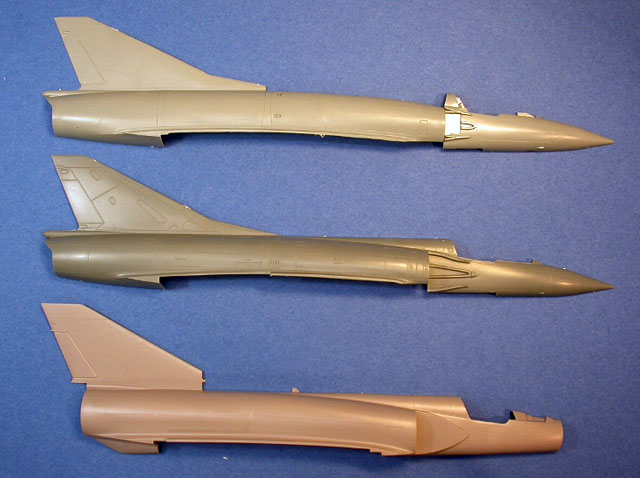
Click the thumbnails below to view
larger images:
Weapons included are 2 JL
100R rocket packs, Matra 530 and AIM-9D sidewinder missiles, as well as 625l
and 500 l (supersonic) external fuel tanks. Markings are included for a
variety of Isreali Air Force machines, in natural metal and camouflage
schemes, some adorned with a considerable number of kill markings. It is to
be hoped that later kits will include the rare French combination of the
100R rocket pack with a supersonic fuel tank.

The sprues do yield one piece of additional good news though: the presence
of elevons not used on the Mirage IIIC, but only on later variants, which
indicates that Eduard is truly planning a Mirage project and not just the
release of an isolated variant. Details of the Mirage IIICZ in real life can
be assessed form the above walk-around photos. Note that this bird has seen
combat and have been modified accordingly (chaff/ flare dispenser in the
belly strake).
Eduard’s 1/48 scale Mirage
IIICJ is magnificent kit, and easily the best that this company has produced
to date. The fact that other variants are being planned is good news for
Mirage fans, as well as decal producers, as these represent some of the most
colourful and widely-used jet aircraft, in an era before everything became a
bland grey.
Highly Recommended.
Thanks to my wife for
indulging me with the review sample!
Israeli
Mirage and Nesher Aces
(Aircraft of the Aces
59) |
|
|
|
|
Author: Shlomo
Aloni
Illustrator: Mark Styling
US Price: $19.95
UK Price: £12.99
Publisher:
Osprey Publishing
Publish Date: February 25, 2004
Details: 96 pages; ISBN: 1841766534 |
|
|
Home | What's
New | Features
| Gallery |
Reviews | Reference
| Forum
| Search